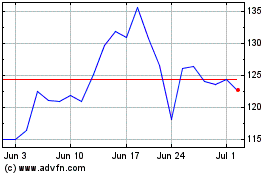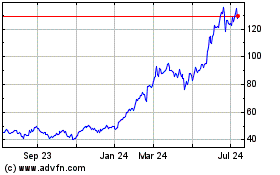COMPUTEX -- NVIDIA today announced that the
world’s 28 million developers can now download NVIDIA NIM™ —
inference microservices that provide models as optimized containers
— to deploy on clouds, data centers or workstations, giving them
the ability to easily build generative AI applications for
copilots, chatbots and more, in minutes rather than weeks.
These new generative AI applications are becoming increasingly
complex and often utilize multiple models with different
capabilities for generating text, images, video, speech and more.
NVIDIA NIM dramatically increases developer productivity by
providing a simple, standardized way to add generative AI to their
applications.
NIM also enables enterprises to maximize their infrastructure
investments. For example, running Meta Llama 3-8B in a NIM produces
up to 3x more generative AI tokens on accelerated infrastructure
than without NIM. This lets enterprises boost efficiency and use
the same amount of compute infrastructure to generate more
responses.
Nearly 200 technology partners — including Cadence, Cloudera,
Cohesity, DataStax, NetApp, Scale AI and Synopsys — are integrating
NIM into their platforms to speed generative AI deployments for
domain-specific applications, such as copilots, code assistants and
digital human avatars. Hugging Face is now offering NIM — starting
with Meta Llama 3.
“Every enterprise is looking to add generative AI to its
operations, but not every enterprise has a dedicated team of AI
researchers,” said Jensen Huang, founder and CEO of NVIDIA.
“Integrated into platforms everywhere, accessible to developers
everywhere, running everywhere — NVIDIA NIM is helping the
technology industry put generative AI in reach for every
organization.”
Enterprises can deploy AI applications in production with NIM
through the NVIDIA AI Enterprise software platform. Starting next
month, members of the NVIDIA Developer Program can access NIM for
free for research, development and testing on their preferred
infrastructure.
40+ NIM Microservices Power Gen AI
Models Across ModalitiesNIM containers are pre-built to
speed model deployment for GPU-accelerated inference and can
include NVIDIA CUDA® software, NVIDIA Triton Inference Server™ and
NVIDIA TensorRT™-LLM software.
Over 40 NVIDIA and community models are available to experience
as NIM endpoints on ai.nvidia.com, including Databricks DBRX,
Google’s open model Gemma, Meta Llama 3, Microsoft Phi-3, Mistral
Large, Mixtral 8x22B and Snowflake Arctic.
Developers can now access NVIDIA NIM microservices for Meta
Llama 3 models from the Hugging Face AI platform. This lets
developers easily access and run the Llama 3 NIM in just a few
clicks using Hugging Face Inference Endpoints, powered by NVIDIA
GPUs on their preferred cloud.
Enterprises can use NIM to run applications for generating text,
images and video, speech and digital humans. With NVIDIA BioNeMo™
NIM microservices for digital biology, researchers can build novel
protein structures to accelerate drug discovery.
Dozens of healthcare companies are deploying NIM to power
generative AI inference across a range of applications, including
surgical planning, digital assistants, drug discovery and clinical
trial optimization.
With new NVIDIA ACE NIM microservices, developers can easily
build and operate interactive, lifelike digital humans in
applications for customer service, telehealth, education, gaming
and entertainment.
Hundreds of AI
Ecosystem Partners Embedding NIM Platform
providers including Canonical, Red Hat, Nutanix and VMware
(acquired by Broadcom) are supporting NIM on open-source KServe or
enterprise solutions. AI application companies Hippocratic AI,
Glean, Kinetica and Redis are also deploying NIM to power
generative AI inference.
Leading AI tools and MLOps partners — including Amazon
SageMaker, Microsoft Azure AI, Dataiku, DataRobot, deepset, Domino
Data Lab, LangChain, Llama Index, Replicate, Run.ai, Saturn Cloud,
Securiti AI and Weights & Biases — have also embedded NIM into
their platforms to enable developers to build and deploy
domain-specific generative AI applications with optimized
inference.
Global system integrators and service delivery partners
Accenture, Deloitte, Infosys, Latentview, Quantiphi, SoftServe, TCS
and Wipro have created NIM competencies to help the world’s
enterprises quickly develop and deploy production AI
strategies.
Enterprises can run NIM-enabled applications virtually anywhere,
including on NVIDIA-Certified Systems™ from global infrastructure
manufacturers Cisco, Dell Technologies, Hewlett-Packard Enterprise,
Lenovo and Supermicro, as well as server manufacturers ASRock Rack,
ASUS, GIGABYTE, Ingrasys, Inventec, Pegatron, QCT, Wistron and
Wiwynn. NIM microservices have also been integrated into Amazon Web
Services, Google Cloud, Azure and Oracle Cloud Infrastructure.
Titans of Industry Amp Up Generative AI
With NIMIndustry leaders Foxconn, Pegatron, Amdocs,
Lowe’s, ServiceNow and Siemens are among the businesses using NIM
for generative AI applications in manufacturing, healthcare,
financial services, retail, customer service and more:
-
Foxconn — the world’s largest electronics
manufacturer — is using NIM in the development of domain-specific
LLMs embedded into a variety of internal systems and processes in
its AI factories for smart manufacturing, smart cities and smart
electric vehicles.
-
Pegatron — a Taiwanese electronics manufacturing
company — is leveraging NIM for Project TaME, a Taiwan Mixtral of
Experts model designed to advance the development of local LLMs for
industries.
-
Amdocs — a leading global provider of software and
services to communications and media companies — is using NIM to
run a customer billing LLM that significantly lowers the cost of
tokens, improves accuracy by up to 30% and reduces latency by 80%,
driving near real-time responses.
-
Lowe’s — a FORTUNE® 50 home improvement company —
is using generative AI for a variety of use cases. For example, the
retailer is leveraging NVIDIA NIM inference microservices to
elevate experiences for associates and customers.
-
ServiceNow — the AI platform for business
transformation — announced earlier this year that it was one of the
first platform providers to access NIM to enable fast, scalable and
more cost-effective LLM development and deployment for its
customers. NIM microservices are integrated within the Now AI
multimodal model and are available to customers that have
ServiceNow’s generative AI experience, Now Assist, installed.
-
Siemens — a global technology company focused on
industry, infrastructure, transport and healthcare — is integrating
its operational technology with NIM microservices for shop floor AI
workloads. It is also building an on-premises version of its
Industrial Copilot for Machine Operators using NIM.
AvailabilityDevelopers can experiment with
NVIDIA microservices at ai.nvidia.com at no charge. Enterprises can
deploy production-grade NIM microservices with NVIDIA AI Enterprise
running on NVIDIA-Certified Systems and leading cloud platforms.
Starting next month, members of the NVIDIA Developer Program will
gain free access to NIM for research and testing.
Watch Huang’s COMPUTEX keynote to learn more about NVIDIA
NIM.
About NVIDIANVIDIA (NASDAQ: NVDA) is the world
leader in accelerated computing.
For further information, contact:Anna
KiachianNVIDIA Corporation+1-650-224-9820akiachian@nvidia.com
Certain statements in this press release including, but not
limited to, statements as to: the benefits, impact, performance,
features, and availability of NVIDIA’s products and technologies,
including NVIDIA NIM, NVIDIA CUDA, NVIDIA Triton Inference Server,
NVIDIA TensorRT-LLM software, NVIDIA Developer program, NVIDIA
BioNeMo, NVIDIA-Certified Systems, and NVIDIA AI Enterprise; our
collaborations and partnerships with third parties and the benefits
and impacts thereof; third parties using or adopting our products
or technologies; every enterprise looking to add generative AI to
its operations; and NVIDIA NIM helping the technology industry put
generative AI in reach for every organization are forward-looking
statements that are subject to risks and uncertainties that could
cause results to be materially different than expectations.
Important factors that could cause actual results to differ
materially include: global economic conditions; our reliance on
third parties to manufacture, assemble, package and test our
products; the impact of technological development and competition;
development of new products and technologies or enhancements to our
existing product and technologies; market acceptance of our
products or our partners' products; design, manufacturing or
software defects; changes in consumer preferences or demands;
changes in industry standards and interfaces; unexpected loss of
performance of our products or technologies when integrated into
systems; as well as other factors detailed from time to time in the
most recent reports NVIDIA files with the Securities and Exchange
Commission, or SEC, including, but not limited to, its annual
report on Form 10-K and quarterly reports on Form 10-Q. Copies of
reports filed with the SEC are posted on the company's website and
are available from NVIDIA without charge. These forward-looking
statements are not guarantees of future performance and speak only
as of the date hereof, and, except as required by law, NVIDIA
disclaims any obligation to update these forward-looking statements
to reflect future events or circumstances.
© 2024 NVIDIA Corporation. All rights reserved. NVIDIA, the
NVIDIA logo, BioNeMo, CUDA, NVIDIA NIM, NVIDIA Triton Inference
Server and TensorRT are trademarks and/or registered trademarks of
NVIDIA Corporation in the U.S. and other countries. Other company
and product names may be trademarks of the respective companies
with which they are associated. Features, pricing, availability and
specifications are subject to change without notice.
A photo accompanying this announcement is available
at:https://www.globenewswire.com/NewsRoom/AttachmentNg/4fe99b19-66e7-4473-b9ff-f1380eae0ff8
NVIDIA (NASDAQ:NVDA)
Historical Stock Chart
From May 2024 to Jun 2024

NVIDIA (NASDAQ:NVDA)
Historical Stock Chart
From Jun 2023 to Jun 2024
